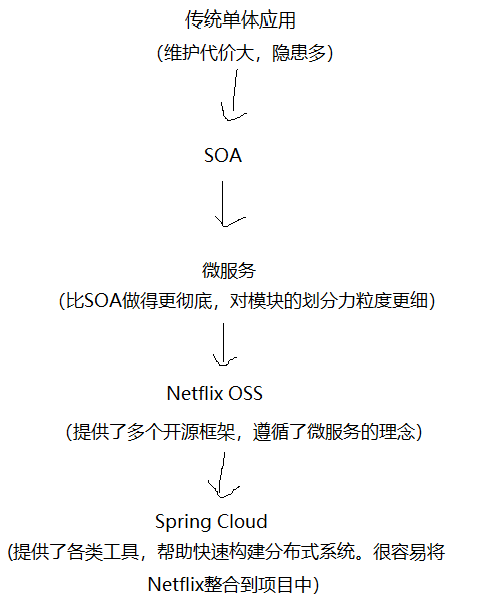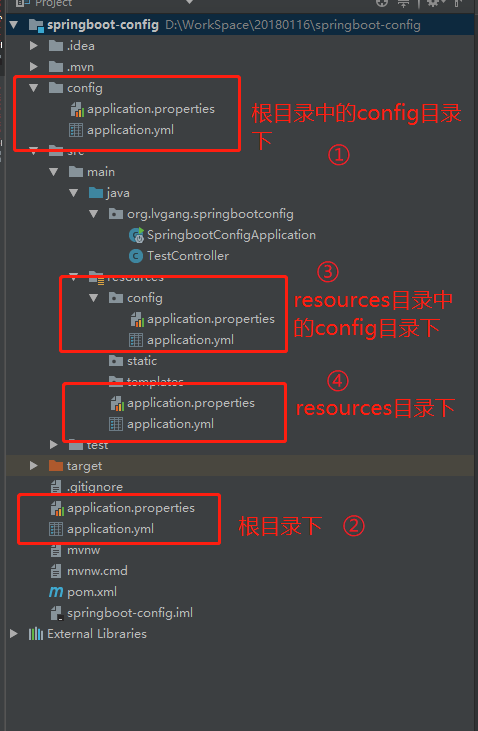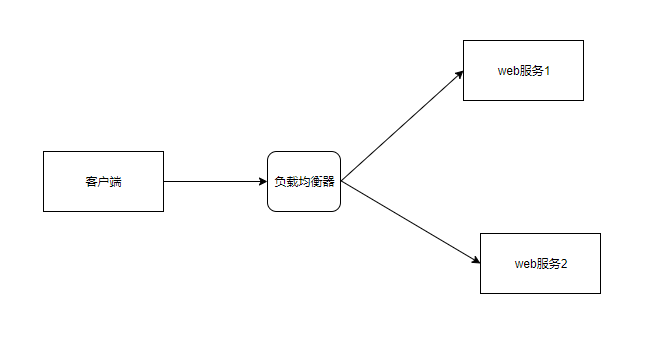SpringBoot —— 注入数据的方式
关于注入数据说明

方式一:不通过配置文件注入数据(@Value注解实现)
通过@Value将外部的值动态注入到Bean中,使用的情况有:
- 注入普通字符串
- 注入操作系统属性
- 注入表达式结果
- 注入其他Bean属性:注入Student对象的属性name
- 注入文件资源
- 注入URL资源
辅助代码
package com.hannpang.model;import org.springframework.beans.factory.annotation.Value;import org.springframework.stereotype.Component;@Component(value = "st")//对student进行实例化操作public class Student {@Value("悟空")private String name;public String getName() {return name;}public void setName(String name) {this.name = name;}}
测试@Value的代码
package com.hannpang.model;import org.springframework.beans.factory.annotation.Value;import org.springframework.core.io.Resource;import org.springframework.stereotype.Component;@Componentpublic class SimpleObject {@Value("注入普通字符串")private String normal;//关于属性的KEY可以查看System类说明@Value("#{systemProperties['java.version']}")//-->使用了SpEL表达式private String systemPropertiesName; // 注入操作系统属性@Value("#{T(java.lang.Math).random()*80}")//获取随机数private double randomNumber; //注入表达式结果@Value("#{1+2}")private double sum; //注入表达式结果 1+2的求和@Value("classpath:os.yaml")private Resource resourceFile; // 注入文件资源@Value("http://www.baidu.com")private Resource testUrl; // 注入URL资源@Value("#{st.name}")private String studentName;//省略getter和setter方法@Overridepublic String toString() {return "SimpleObject{" +"normal='" + normal + '\'' +", systemPropertiesName='" + systemPropertiesName + '\'' +", randomNumber=" + randomNumber +", sum=" + sum +", resourceFile=" + resourceFile +", testUrl=" + testUrl +", studentName='" + studentName + '\'' +'}';}}
Spring的测试代码
package com.hannpang;import com.hannpang.model.SimpleObject;import org.junit.Test;import org.junit.runner.RunWith;import org.springframework.beans.factory.annotation.Autowired;import org.springframework.boot.test.context.SpringBootTest;import org.springframework.test.context.junit4.SpringRunner;@RunWith(SpringRunner.class)@SpringBootTestpublic class Demo04BootApplicationTests {@Autowiredprivate SimpleObject so;@Testpublic void contextLoads() {System.out.println(so);}}
运行结果为:SimpleObject{normal=’注入普通字符串’, systemPropertiesName=’1.8.0_172’, randomNumber=56.631954541947266, sum=3.0, resourceFile=class path resource [os.yaml], testUrl=URL [http://www.baidu.com\], studentName=’悟空’}
方式二:通过配置文件注入数据
通过@Value将外部配置文件的值动态注入到Bean中。配置文件主要有两类:
application.properties、application.yaml application.properties在spring boot启动时默认加载此文件
自定义属性文件。自定义属性文件通过@PropertySource加载。@PropertySource可以同时加载多个文件,也可以加载单个文件。如果相同第一个属性文件和第二属性文件存在相同key,则最后一个属性文件里的key起作用。加载文件的路径也可以配置变量,如下文的${anotherfile.configinject},此值定义在第一个属性文件config.properties
在application.properties中加入如下测试代码
app.name=一步教育
在resources下面新建第一个属性文件config.properties内容如下
book.name=西游记anotherfile.configinject=system
在resources下面新建第二个属性文件config_system.properties内容如下
我的目的是想system的值使用第一个属性文件中定义的值
book.name.author=吴承恩
下面通过@Value(“${app.name}”)语法将属性文件的值注入bean属性值,详细代码见:
package com.hannpang.test;import org.springframework.beans.factory.annotation.Autowired;import org.springframework.beans.factory.annotation.Value;import org.springframework.context.annotation.PropertySource;import org.springframework.core.env.Environment;import org.springframework.stereotype.Component;@Component@PropertySource(value = {"classpath:config.properties","classpath:config_${anotherfile.configinject}.properties"})public class LoadPropsTest {@Value("${app.name}")private String appName; // 这里的值来自application.properties,spring boot启动时默认加载此文件@Value("${book.name}")private String bookName; // 注入第一个配置外部文件属性@Value("${book.name.author}")private String author; // 注入第二个配置外部文件属性@Autowiredprivate Environment env; // 注入环境变量对象,存储注入的属性值//省略getter和setter方法public void setAuthor(String author) {this.author = author;}@Overridepublic String toString(){StringBuilder sb = new StringBuilder();sb.append("bookName=").append(bookName).append("\r\n").append("author=").append(author).append("\r\n").append("appName=").append(appName).append("\r\n").append("env=").append(env).append("\r\n")// 从eniroment中获取属性值.append("env=").append(env.getProperty("book.name.author")).append("\r\n");return sb.toString();}}
测试代码
package com.hannpang;import com.hannpang.model.SimpleObject;import com.hannpang.test.LoadPropsTest;import org.junit.Test;import org.junit.runner.RunWith;import org.springframework.beans.factory.annotation.Autowired;import org.springframework.boot.test.context.SpringBootTest;import org.springframework.test.context.junit4.SpringRunner;@RunWith(SpringRunner.class)@SpringBootTestpublic class Demo04BootApplicationTests {@Autowiredprivate LoadPropsTest lpt;@Testpublic void loadPropertiesTest() {System.out.println(lpt);}}
运行结果为:
bookName=西游记
author=吴承恩
appName=一步教育
env=StandardEnvironment {activeProfiles=[], defaultProfiles=[default], propertySources=[ConfigurationPropertySourcesPropertySource {name=’configurationProperties’}, MapPropertySource {name=’Inlined Test Properties’}, MapPropertySource {name=’systemProperties’}, OriginAwareSystemEnvironmentPropertySource {name=’systemEnvironment’}, RandomValuePropertySource {name=’random’}, OriginTrackedMapPropertySource {name=’applicationConfig: [classpath:/application.properties]‘}, ResourcePropertySource {name=’class path resource [config_system.properties]‘}, ResourcePropertySource {name=’class path resource [config.properties]‘}]}
env=吴承恩
#{…}和${…}的区别演示
A.${…}的用法
{}里面的内容必须符合SpEL表达式,通过@Value(“${app.name}”)可以获取属性文件中对应的值,但是如果属性文件中没有这个属性,则会报错。可以通过赋予默认值解决这个问题,如@Value("${app.name:胖先森}")
部分代码
// 如果属性文件没有app.name,则会报错// @Value("${app.name}")// private String name;// 使用app.name设置值,如果不存在则使用默认值@Value("${app.name:胖先森}")private String name;
B.#{…}的用法
部分代码直接演示
// SpEL:调用字符串Hello World的concat方法@Value("#{'Hello World'.concat('!')}")private String helloWorld;// SpEL: 调用字符串的getBytes方法,然后调用length属性@Value("#{'Hello World'.bytes.length}")private String helloWorldbytes;
C.#{…}和${…}混合使用
${...}和#{...}可以混合使用,如下文代码执行顺序:通过${server.name}从属性文件中获取值并进行替换,然后就变成了 执行SpEL表达式{‘server1,server2,server3’.split(‘,’)}。
// SpEL: 传入一个字符串,根据","切分后插入列表中, #{}和${}配置使用(注意单引号,注意不能反过来${}在外面,#{}在里面)@Value("#{'${server.name}'.split(',')}")private List<String> servers;
在上文中在#{}外面,${}在里面可以执行成功,那么反过来是否可以呢${}在外面,#{}在里面,如代码
// SpEL: 注意不能反过来${}在外面,#{}在里面,这个会执行失败@Value("${#{'HelloWorld'.concat('_')}}")private List<String> servers2;
答案是不能。
因为spring执行${}是时机要早于#{}。
在本例中,Spring会尝试从属性中查找#{‘HelloWorld’.concat(‘_’)},那么肯定找到,由上文已知如果找不到,然后报错。所以${}在外面,#{}在里面是非法操作
D.用法总结
#{…}用于执行SpEl表达式,并将内容赋值给属性${…}主要用于加载外部属性文件中的值#{…}和${…}可以混合使用,但是必须#{}外面,${}在里面
@Value获取值和@ConfigurationProperties获取值比较

配置文件yml还是properties他们都能获取到值;
- 如果说,我们只是在某个业务逻辑中需要获取一下配置文件中的某项值,使用@Value;
- 如果说,我们专门编写了一个javaBean来和配置文件进行映射,我们就直接使用@ConfigurationProperties;
关于数据校验的部分代码
@Component@ConfigurationProperties(prefix = "person")@Validatedpublic class Person {//lastName必须是邮箱格式private String lastName;
@ImportResource引入配置文件(不推荐的使用方式)
Spring Boot里面没有Spring的配置文件,我们自己编写的配置文件,也不能自动识别;
想让Spring的配置文件生效,加载进来;@ImportResource标注在一个配置类上
@ImportResource(locations = {"classpath:beans.xml"})
导入Spring的配置文件让其生效,编写配置文件信息
<?xml version="1.0" encoding="UTF-8"?><beans xmlns="http://www.springframework.org/schema/beans"xmlns:xsi="http://www.w3.org/2001/XMLSchema-instance"xsi:schemaLocation="http://www.springframework.org/schema/beans http://www.springframework.org/schema/beans/spring-beans.xsd"><bean id="helloService" class="com.hanpang.springboot.service.HelloService"></bean></beans>
大概了解就好,我们基本上不使用这种方式
@Configuration注解
SpringBoot推荐给容器中添加组件的方式;推荐使用全注解的方式
- 配置类@Configuration作用于类上,相当于一个xml配置文件
使用@Bean给容器中添加组件,作用于方法上
/**
- @Configuration:指明当前类是一个配置类;就是来替代之前的Spring配置文件
* - 在配置文件中用
标签添加组件
*/
@Configuration
public class MyAppConfig {//将方法的返回值添加到容器中;容器中这个组件默认的id就是方法名
@Bean
public HelloService helloService02(){System.out.println("配置类@Bean给容器中添加组件了...");return new HelloService();
}
}
- @Configuration:指明当前类是一个配置类;就是来替代之前的Spring配置文件
使用Bean注入太麻烦,我们更加喜欢使用扫描的方式
import org.springframework.context.annotation.Bean;import org.springframework.context.annotation.ComponentScan;import org.springframework.context.annotation.Configuration;import com.wx.dao.IUserDao;import com.wx.dao.UserDaoImpl;//通过该注解来表明该类是一个Spring的配置,相当于一个传统的ApplicationContext.xml@Configuration//相当于配置文件里面的<context:component-scan/>标签,扫描这些包下面的类的注解@ComponentScan(basePackages="com.hanpang.dao,com.hanpang.service")public class SpringConfig {// 通过该注解来表明是一个Bean对象,相当于xml中的<bean>//bean的id值默认是方法名userDao/*@Beanpublic HelloService helloService02(){System.out.println("配置类@Bean给容器中添加组件了...");return new HelloService();}*/}
附录
随机数
${random.value}、${random.int}、${random.long}${random.int(10)}、${random.int[1024,65536]}



































还没有评论,来说两句吧...